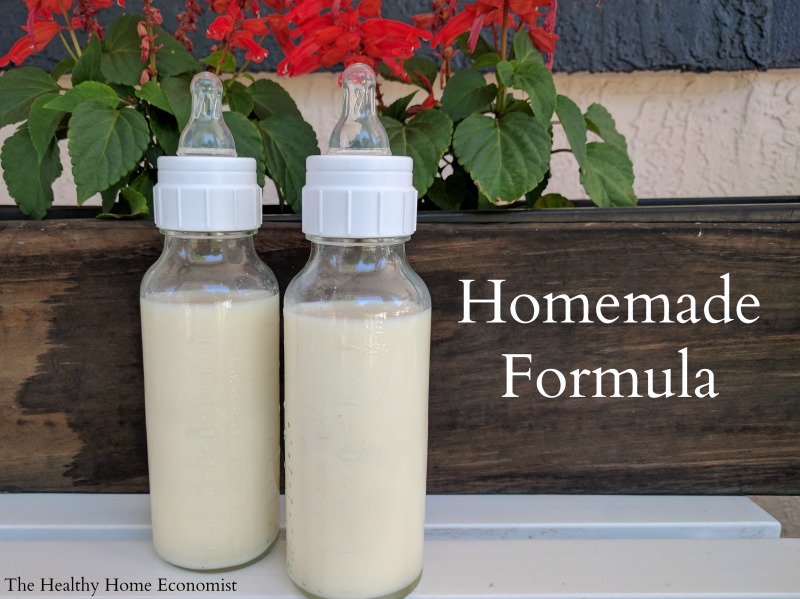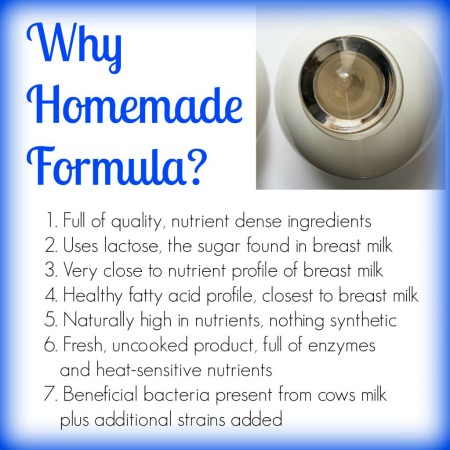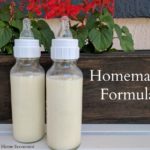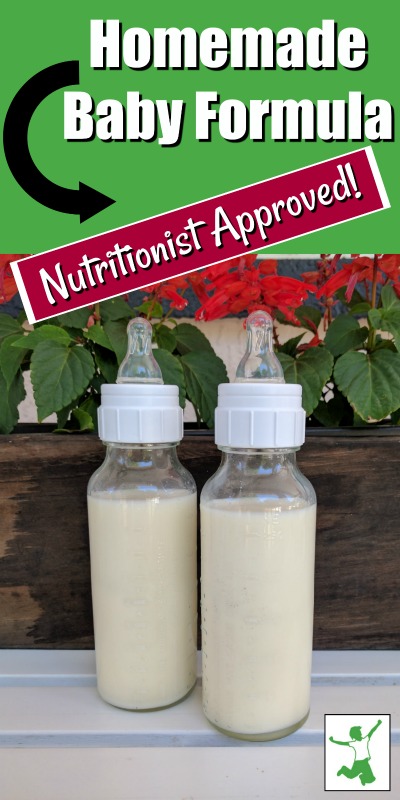Table of Contents[Hide][Show]
A nourishing homemade baby formula using safe, whole ingredients. This recipe was developed and tested by Dr. Mary Enig, a PhD Nutritionist and originally published in Nourishing Traditions cookbook in 1996. It was formulated to match breastmilk as closely as possible and is also suitable for infants. Source: Weston A. Price Foundation

There is no doubt that breastfeeding your baby is the best option for the child’s long-term health and development. Human breastmilk from a well-nourished mother is the perfect food for baby. However, in circumstances where the child is adopted or the Mother finds herself unable to breastfeed, formula feeding becomes necessary. In those cases, homemade baby formula is best.
Using a baby formula recipe that closely matches the nutritional profile of breastmilk is a far better choice than even organic baby formula from the health food store. More on this below.
Note: Donor programs are widely available for human breastmilk. But, the diets of the donor mothers are unknown and most likely nutritionally insufficient. In addition, breastmilk banks pasteurize the donated breastmilk which destroys much of the nutritional benefit. Unless you are fortunate to have a trusted and direct donor milk source in your community, avoid this option!
Dangers of Commercial Formula
Commercial formulas are always a poor choice for a number of reasons. First of all, formula manufacturers line the cans with the chemical BPA. This substance disrupts hormone development and is a probable contributor to early puberty in girls, and ADHD, urogenital abnormalities, and other ills in boys.
The European Food Safety Authority found that canned commercial formula is a significant source of BPA for infants, exposing the child to 13mcg of BPA per kg of body weight per day! BPA-free formula cans are no better. The chemical BPS is typically used instead which is just as dangerous.
Beware that manufacturers pack even organic commercial formula like Earth’s Best in BPA cans. Worse, they use organic brown rice syrup as the primary sweetener which is known to be frequently contaminated with arsenic.
In addition, all commercial milk formulas are processed at extremely high temperatures which violently denature the fragile milk proteins, render them allergenic, and add carcinogens to the final product. Soy infant formula is the worst. Obscenely high processing temperatures not only denature the proteins but large levels of phytic acid in soy block mineral absorption by the infant. Moreover, soy-based plant estrogens disrupt the hormonal development of the baby!
It seems that for the concerned Mother who is unable to breastfeed, learning how to make baby formula at home with safe, pure ingredients is the most prudent way to go!
Why Make Homemade Formula Even if You Are Breastfeeding
In the video below, I show you how to make your own safe, healthy raw milk homemade formula for your baby.
The recipe I follow was originally published in the cookbook Nourishing Traditions in 1996 and developed by Dr. Mary Enig.
Even though I breastfed each of my children for at least 2 years, I made this exact formula for my own children when I was away for the day or the evening as pumping was not an option that worked well for me.
I even used this homemade formula for an entire day once when I had some dental work done and was advised to pump and discard for 24 hours.
As a result, even successfully breastfeeding Moms can use this wonderful homemade formula as a supplement when necessary to their own nutrient-dense breastmilk!
It is advised that even breastfeeding Mothers have the ingredients for this formula on hand for an emergency. If Mom is sick or otherwise unable to nurse, Dad can step in and make this safe alternative until Mom is back on her feet. It takes a few days to a week to gather all the ingredients together to make this formula, which is why I advise having them on hand at all times.
Homemade Most Nutritious
The image below lists the reasons why it is worth it nutritionally to make formula yourself for your precious baby!
You can order all of the required ingredients for the homemade baby formula in one package from this reputable, vetted source.
Moms who have successfully used this formula feeding your children, please post about your experience in the comments section to encourage those who are considering it and need some Mom to Mom encouragement!

Where to Source Quality Milk
The most widely available grass-fed milk around the world is from cows. This is usually the most budget-friendly and easily sourced milk for this recipe for homemade formula.
If only goat milk is available in your area, this recipe for goat milk baby formula can be used instead. When using milk from ewes, please refer to the linked article for an adjusted recipe; one of the benefits of sheep milk is that it is higher in healthy fats than either goat or cow milk.
Camel milk formula is another option that is a particularly digestible form of dairy and growing in popularity around the world.
Alternatively, you can use low temp (vat) pasteurized, non-homogenized whole milk cultured with a piima or kefir starter. Then substitute the piima milk or kefir for the raw milk portion of the formula recipe. Cold-pressed raw milk also must be cultured before using it as it contains no probiotics.
Do NOT use ultrapasteurized (UHT) milk even if organic as it is too highly processed and extremely allergenic!
It is also best to avoid all types of powdered milk for this recipe. The factory process of making milk powder reduces nutrition considerably and denatures it, which makes it more likely baby will have an allergic reaction.
Dairy Allergy Option
If all types of dairy prove unsuitable for your baby, make this nondairy baby formula recipe instead. It uses a base of homemade bone broth as a substitute for milk. It is important not to utilize a plant-based or otherwise vegan baby formula recipe.
Avoid buying bone broth to make the dairy-free formula. Make it yourself! Manufacturers of commercial bone broth, even if authentic, may water down the end product. This is apparent if it does not gel when chilled in the refrigerator.
Many brands have toxic packaging issues as well. If you must buy it in a pinch, see my shopping guide page for vetted brands that are safe.

Homemade Baby Formula Recipe (for infants too)
A nourishing baby formula recipe you can make at home with safe, whole ingredients developed and tested by a PhD nutritionist to match breastmilk as closely as possible. Also suitable for infants.
Ingredients
- 2 cups raw cow milk OR organic whole milk yogurt
- 1 7/8 cups filtered water
- 1/4 cup liquid whey
- 4 Tbl lactose
- 1/4 tsp Bifidobacterium infantis powder
- 2-4 Tbl raw or pasteurized cream
- 1/2 tsp cod liver oil unflavored
- 1/4 tsp butter oil unflavored
- 1 tsp sunflower oil preferably organic
- 1 tsp extra virgin olive oil preferably organic
- 2 tsp virgin coconut oil preferably organic
- 2 tsp nutritional yeast
- 2 tsp gelatin
- 1/4 tsp acerola powder
Instructions
-
Fill a 2 cup Pyrex measuring cup with filtered water and remove 2 TBL (this will give you 1 7/8 cup water).
-
Pour about half the water into a pan and turn burner on medium.
-
Add the gelatin and lactose and let dissolve, stirring occasionally.
-
When gelatin and lactose are dissolved, remove pan from heat and add the rest of the water to cool.
-
Stir in the coconut oil and butter oil until melted.
-
Put remaining ingredients in a glass blender.
-
Add the water mixture and blend for about 3 seconds.
-
Place formula in glass baby bottles or a glass jar and refrigerate.
-
Before giving to baby, warm glass bottle in a pan of hot water or a bottle warmer. NEVER microwave baby bottles!
Recipe Video
Recipe Notes
If using raw cow milk from holstein cows, use 4 Tbl of extra cream (otherwise use 2 Tbl extra cream).
If choosing to make this homemade formula with camel milk, be sure to include 4 Tbl extra cream as camel milk is lower in cream than cow milk.
Do not use high oleic sunflower oil. Use only the brand recommended in the ingredients list which is cold pressed, organic, unrefined, and low oleic.
*Do NOT use powdered whey from the store as it is denatured. Avoid whey from making cheese as it will curdle the formula.
*Do not substitute pasteurized or powdered milk as these are heavily processed, denatured and allergenic foods.
*Do NOT use ultrapasteurized (UHT) cream. It is highly allergenic. Raw or pasteurized cream is acceptable.
*Do NOT use fish oil or krill oil instead of high vitamin cod liver oil as they do not contain any Vitamin D and very little to no Vitamin A.
Collagen powder may be substituted for the gelatin in a pinch (more on peptides in baby formula in this article).
If you are wondering where is the iron in homemade baby formula, this article provides an explanation.
If baby experiences constipation using this formula, try adding 1 tsp of molasses to each batch. This should help move things along.
How to Transition to DIY Formula
Once you’ve viewed the video, gathered the ingredients, and made your first batch, how do you feed it to your baby for the first time?
It is important not to switch all at once as this can cause gas, excessive spit-up, or an uncomfortable change in diaper habits such as constipation or overly loose stools.
Start by giving your baby three-quarters of the old formula blended with one-quarter of the homemade. Try this ratio for a day or two and see how your infant responds.
If no digestive upset or major change in diaper habits occurs, increase the amount to a 50-50 blend of old formula to homemade. Observe for another day or two as before.
If no major issues, increase once again to three-quarters homemade formula to one-quarter old formula. If baby does well on this blend for a third time, you are ready to fully transition to the homemade formula.
At any time during the transition, symptoms of intolerance emerge, back up to the previous successful blend ratio and stay there for a day or two before attempting to increase once again.
Homemade Formula FAQ
Weston Price Foundation
Feeding an Adopted Baby
Traveling Tips with Baby Formula Made at Home
Iron in Baby Formula
Collagen Peptides instead of Gelatin for Homemade Formula?










Hi Natasha, this formula is fine for a one month old baby. I gave it to my own 3 children when I needed a bottle of supplement for any reason and they were babies. Just be sure to get clean, certified raw milk from a grassfed farmer with jersey cows.
Hi Sarah,
My baby is just one month old and I have to add formula to her breast feeding sessions since my breast milk supply diminished due to mastitis.
Is a one month old baby too young for this formula?
My doctor says she shouldn’t have raw milk till she reaches two years, I hate the thought of giving her commercial formula, even organic formulas have soy in them and many other questionable ingredients.
Thank you for all the great info you provide!
Natasha
Thank you very much for posting this video. I just had a baby and am unable to nurse. I desperately want to start this formula, but raw milk is not easily accessible where I live. The stores here do not sell non-homogenized milk. The only option I have is homogenized, vat-pasteurized grass-fed milk (Vit. D added). But the farms that sell this milk (co-op) are all reliable in their dairy-farming practices. Would it be so terrible if I used this milk to make formula for my 2 week old baby instead of continuing the commercial formula I’m using right now?
Please help,
Dee
Hi Dee, where are you located – perhaps I can help you locate what you need. The milk you are suggesting would not be a great alternative for a baby that young.
Hi Sarah.
First of all I’d like to thank you for making a HUGE difference in my life. I have been unable to breastfeed my fourth child with success through the first three. So, you can imagine my disappointment now. Also, I completely agree that canned formula would never be the right choice for my child. So thank you again!!!
I started feeding this formula to my son one week ago. At first he seemed to do well on it. Now however he gets a bit cranky about half way through the bottle. Like his tummy hurts. I am wondering if this may be from the cows milk and should I maybe change to goats milk or the Hypoallergenic formula. I asked our local health food store and they suggested adding a little lactase and amylase to his bottles.
I’d really appreciate your advice.
Traci
Breastmilk contains more lactose than is in cow’s milk. This is the reason for adding it .. to closely mimic the amount in human breastmilk as possible.
Hi, Still hoping to know what the purpose of lactose powder is in the formula…
Thanks, Beverly
Hi Sara, I do not know of any commercial formulas that are any good on the market. Dr. Mercola is developing one as we speak but it won’t be ready for sale until sometime next year. His will probably be the best one on the market when it comes out, but this is only speculation as I do not know the ingredients list at this time.
Hi Sarah,
My sister-in-law wanted to nurse my nephew but was not able to. When she learned that the hospital put him on a soy based formula, she immediately switched to a milk based formula. I talked to her about a non-soy formula and she was open to the idea. She was not able to find any formulas without soy in them. (Not a surprise to me.) She came to me for advice, they are not open to raw milk, unfortunately, however I think I could convince her to use the “Fortified Commercial Formula” recipe out of Nourishing Traditions. They are more “western” thinkers. On the Weston A Price website I found that the Mead Johnson low-iron milk-based formula is no longer available. Is there another formula that is “less bad”? I want my nephew to be healthy. He is now 2 months old. I know you’re promoting the homemade baby formula with raw milk, I just was hoping that you might be able to help.
Thanks,
Sara
Hi again, Not sure this posted. I am wanting to know the purpose of the lactose powder?
Thanks, Beverly
breast milk is high in lactose.
Erica: Ok sarah thank you. I will take your advice. I am still a little confused because i am such a beginer at traditional foods (the only reason I found out anything about them was from stumbling upon Nina Planks book Real food for mother & baby in the library while i was pregnant so I guess I will have to research the oil thing more when i have time but until then i will trust you. thank you so much,
Erica